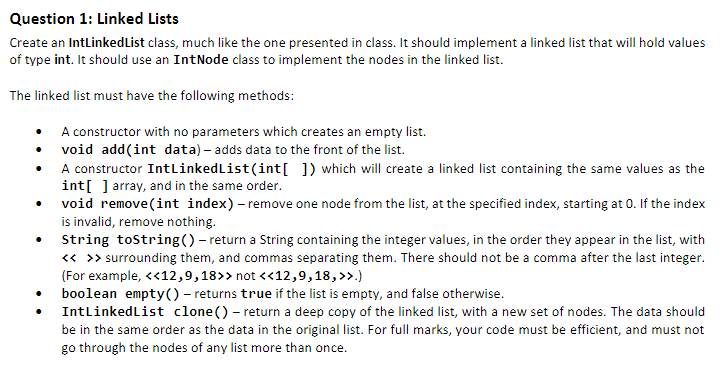Question
------------------------------------------------------------------ TestQuestion1: import java.util.Arrays; public class TestQuestion1 { public static void main(String [] args) { int []testData = {1,2,3,4,5}; IntLinkedList list = new IntLinkedList(testData); System.out.println(These

------------------------------------------------------------------
TestQuestion1:
import java.util.Arrays;
public class TestQuestion1 { public static void main(String [] args) { int []testData = {1,2,3,4,5}; IntLinkedList list = new IntLinkedList(testData); System.out.println("These two lists should be in the same order:"); System.out.println(list.toString()); System.out.println(Arrays.toString(testData)); System.out.println("Is the above list empty? " + list.empty());
IntLinkedList list2 = new IntLinkedList(); System.out.println(" List 2: "+list2); System.out.println("Is List 2 empty? " + list2.empty()); list.remove(4); list.remove(0); System.out.println(" Should contain 2,3,4:"); System.out.println(list); // will the code crash? list.remove(0); list.remove(0); // Next test int []testData2 = {7,4,5,15,0,1}; IntLinkedList list3 = new IntLinkedList(testData2); System.out.println(" The new list: " + list3); //System.out.println(" The new list reversed: " + list2.printReverse()); // clone some data IntLinkedList cloned = list3.clone(); System.out.println(" Old list and new list should be identical:"); System.out.println("Old: " + list3); System.out.println("New: " + cloned); cloned.add(88); cloned.add(99); System.out.println(" The old list should be unchanged:"); System.out.println("Old: " + list3); System.out.println("New: " + cloned); // remove elements that don't exist cloned.remove(-1); cloned.remove(100); System.out.println(" The new list should be unchanged:"); System.out.println("New: " + cloned);
} }
Question 1: Linked Lists Create an IntLinkedList class, much like the one presented in class. It should implement a linked list that will hold values of type int. It should use an IntNode class to implement the nodes in the linked list. The linked list must have the following methods: A constructor with no parameters which creates an empty list. . void add(int data)- adds data to the front of the list. A constructor IntLinkedList(intl ) which will create a linked list containing the same values as the int ] array, and in the same order. void remove(int index) -remove one node from the list, at the specified index, starting at 0. If the index is invalid, remove nothing. String toString() - return a String containing the integer values, in the order they appear in the list, with > surrounding them, and commas separating them. There should not be a comma after the last integer For example,??12,9,18>> not??12, 9, 18,>>) boolean empty)-returns true if the list is empty, and false otherwise. IntLinkedList clone() return a deep copy of the linked list, with a new set of nodes. The data should be in the same order as the data in the original list. For full marks, your code must be efficient, and must not go through the nodes of any list more than onceStep by Step Solution
There are 3 Steps involved in it
Step: 1

Get Instant Access to Expert-Tailored Solutions
See step-by-step solutions with expert insights and AI powered tools for academic success
Step: 2

Step: 3

Ace Your Homework with AI
Get the answers you need in no time with our AI-driven, step-by-step assistance
Get Started


